Reconfigurable Intelligent Surface-Assisted Antenna Design with Enhanced Beam Steering and Performance Benchmarking
Abstract
1. Introduction
2. Antenna Design and Geometrical Details
3. Design Methodology
3.1. Antenna Performance Without RIS Inclusions
3.2. RIS Design and Analysis
3.3. Effects of RIS Introduction
4. Experimental Realizations and Measurements
4.1. Antenna Performance Validation
4.2. Channel Performance
5. Conclusions
Author Contributions
Funding
Data Availability Statement
Acknowledgments
Conflicts of Interest
References
- Wu, Q.; Zhang, R. Toward smart and reconfigurable environment: Intelligent reflecting surface aided wireless network. IEEE Commun. Mag. 2020, 58, 106–112. [Google Scholar] [CrossRef]
- Di Renzo, M.; Debbah, M.; Phan-Huy, D.-T.; Zappone, A.; Alouini, M.-S.; Yuen, C.; Sciancalepore, V.; Alexandropoulos, G.C.; Hoydis, J.; Gacanin, H.; et al. Smart radio environments empowered by reconfigurable AI meta-surfaces: An idea whose time has come. J. Wirel. Commun. Netw. 2019, 2019, 129. [Google Scholar] [CrossRef]
- Björnson, E.; Özdogan, Ö.; Larsson, E.G. Intelligent Reflecting Surface Versus Decode-and-Forward: How Large Surfaces are Needed to Beat Relaying? IEEE Wirel. Commun. Lett. 2020, 9, 244–248. [Google Scholar] [CrossRef]
- Tang, W.; Dai, J.Y.; Chen, M.; Li, X.; Cheng, Q.; Jin, S.; Wong, K.-K.; Cui, T.J. Programmable metasurface-based RF chain-free 8PSK wireless transmitter. Electron. Lett. 2019, 55, 417–420. [Google Scholar] [CrossRef]
- Huang, C.; Alexandropoulos, G.C.; Yuen, C.; Debbah, M. Indoor Signal Focusing with Deep Learning Designed Reconfigurable Intelligent Surfaces. In Proceedings of the 2019 IEEE 20th International Workshop on Signal Processing Advances in Wireless Communications (SPAWC), Cannes, France, 2–5 July 2019; pp. 1–5. [Google Scholar] [CrossRef]
- Gudla, V.V.; Kumaravelu, V.B.; Imoize, A.L.; Castillo Soria, F.R.; Sujatha, A.B.; John Kennedy, H.S.; Jadhav, H.K.; Murugadass, A.; Sur, S.N. Performance Analysis of Reconfigurable Intelligent Surface-Assisted Millimeter Wave Massive MIMO System Under 3GPP 5G Channels. Information 2025, 16, 396. [Google Scholar] [CrossRef]
- Ali, Q.; Shahzad, W.; Ahmad, I.; Safiq, S.; Bin, X.; Abbas, S.M.; Sun, H. Recent Developments and Challenges on Beam Steering Characteristics of Reconfigurable Transmitarray Antennas. Electronics 2022, 11, 587. [Google Scholar] [CrossRef]
- Worka, C.E.; Khan, F.A.; Ahmed, Q.Z.; Sureephong, P.; Alade, T. Reconfigurable Intelligent Surface (RIS)-Assisted Non-Terrestrial Network (NTN)-Based 6G Communications: A Contemporary Survey. Sensors 2024, 24, 6958. [Google Scholar] [CrossRef]
- Puspitasari, A.A.; Lee, B.M. A Survey on Reinforcement Learning for Reconfigurable Intelligent Surfaces in Wireless Communications. Sensors 2023, 23, 2554. [Google Scholar] [CrossRef]
- Yu, Y.; Wang, J.; Zhou, X.; Wang, C.; Bai, Z.; Ye, Z. Review on Channel Estimation for Reconfigurable Intelligent Surface Assisted Wireless Communication System. Mathematics 2023, 11, 3235. [Google Scholar] [CrossRef]
- Souto, V.D.P.; Souza, R.D.; Uchôa-Filho, B.F.; Li, Y. Intelligent Reflecting Surfaces Beamforming Optimization with Statistical Channel Knowledge. Sensors 2022, 22, 2390. [Google Scholar] [CrossRef]
- Chen, J.; Liang, Y.-C.; Pei, Y.; Guo, H. Intelligent Reflecting Surface: A Programmable Wireless Environment for Physical Layer Security. IEEE Access 2019, 7, 82599–82612. [Google Scholar] [CrossRef]
- Chen, X.; Ye, J.; Wei, Y.; Shi, J.; Zhu, J. Deep Learning-Based Joint Beamforming Design for Multi-Hop Reconfigurable Intelligent Surface (RIS)-Aided Communication Systems. Electronics 2024, 13, 3570. [Google Scholar] [CrossRef]
- Rapudu, T.C.; Oyerinde, O.O. Machine Learning-Based Channel Estimation for Multi-RIS-Assisted mmWave Massive-MIMO OFDM System in a Dynamic Environment. IEEE Trans. Wirel. Commun. 2025, 24, 5297–5309. [Google Scholar] [CrossRef]
- Tang, W.; Chen, M.Z.; Dai, J.Y.; Zeng, Y.; Zhao, X.; Jin, S.; Cheng, Q.; Cui, T.J. Wireless Communications with Programmable Metasurface: New Paradigms, Opportunities, and Challenges on Transceiver Design. IEEE Wirel. Commun. 2020, 27, 180–187. [Google Scholar] [CrossRef]
- You, X.; Wang, C.-X.; Huang, J.; Gao, X.; Zhang, Z.; Wang, M.; Huang, Y.; Zhang, C.; Jiang, Y.; Wang, J.; et al. Towards 6G wireless communication networks: Vision, enabling technologies, and new paradigm shifts. Sci. China Inf. Sci. 2021, 64, 110301. [Google Scholar] [CrossRef]
- Qian, B.; Qiao, J.; Zhang, C. STAR-RIS-Assisted Millimeter-Wave Secure Communication with Multiple Eavesdroppers. Mathematics 2024, 12, 2259. [Google Scholar] [CrossRef]
- Bashar, B.S.; Al-Sharify, T.A.; Rhazali, Z.A.; Misran, H.; Ismail, M.M.; Oleiwi, T.A. Miniaturized MTM Antenna for 5.7 GHz Services. In Proceedings of the 2024 4th International Conference on Artificial Intelligence and Signal Processing (AISP), Vijayawada, India, 26–28 October 2024; pp. 1–5. [Google Scholar] [CrossRef]
- Bashar, B.S.; Mejbel, B.G.; Rhazali, Z.A.; Misran, H.; Ismail, M.M.; Oleiwi, T.A. Design of Metasurface Antenna for 5G Applications. In Proceedings of the 2024 4th International Conference on Artificial Intelligence and Signal Processing (AISP), Vijayawada, India, 26–28 October 2024; pp. 1–4. [Google Scholar] [CrossRef]
- Al Naiemy, Y.; Abdulateef, A.N.; Hamad, A.R.; Ismael, M.S.; Ruthramurthy, B.; Elwi, T.A.; Nagy, L.; Zwick, T. A Further Realization of Binary Genetic Algorithm to Design a Dual Frequency Band Rectenna for Energy Harvesting in 5G Networks. Diyala J. Eng. Sci. 2025, 18, 203–214. [Google Scholar] [CrossRef]
- Kamil, R.A.; Alsabti, S.M.B.; Abdulsattar, R.K.; Mohammed, A.H.; Elwi, T.A. On the Enhancement Anomaly Detection for RF Bio-Sensors by Computing Artificial Networks Using Machine Learning Techniques. Infocommun. J. 2025, XVII, 89–95. [Google Scholar] [CrossRef]
- Verho, S.; Nguyen, V.T.; Chung, J.-Y. A 4 × 4 Active Antenna Array with Adjustable Beam Steering. Sensors 2023, 23, 1324. [Google Scholar] [CrossRef]
- Nabeel, M.I.; Singh, K.; Afzal, M.U.; Thalakotuna, D.N.; Esselle, K.P. Dual-Band Passive Beam Steering Antenna Technologies for Satellite Communication and Modern Wireless Systems: A Review. Sensors 2024, 24, 6144. [Google Scholar] [CrossRef]
- Dmitriev, V.; de Oliveira, R.M.S.; Paiva, R.R.; Rodrigues, N.R.N.M. Multifunctional THz Graphene Antenna with 360° Continuous ϕ-Steering and θ-Control of Beam. Sensors 2023, 23, 6900. [Google Scholar] [CrossRef] [PubMed]
- Verho, S.; Chung, J.-Y. Design of a Compact and Minimalistic Intermediate Phase Shifting Feed Network for Ka-Band Electrical Beam Steering. Sensors 2024, 24, 1235. [Google Scholar] [CrossRef]
- Ma, S.; Li, X.-N.; Li, Z.-D.; Ding, J.-J. Electronic Beam Steering Metamaterial Antenna with Dual-Tuned Mode of Liquid Crystal Material. Sensors 2023, 23, 2556. [Google Scholar] [CrossRef] [PubMed]
- Taher, F.; Rasheed, W.S.; Elwi, T.A.; Al-Khaylani, H.H.; Sree, M.F.A.; Fatah, S.Y.A.; Abdel-aleim, M.M.; El-Din, M.S.H.S. Novel Reconfigurable Fractal Antenna Design for Modern Communication Systems. J. Adv. Res. Appl. Sci. Eng. Technol. 2025, 64, 47–57. [Google Scholar] [CrossRef]
- Ali, M.M.; Segura, E.M.; Elwi, T.A. Advancements in Ku Band Resonator Composite Right/Left-Handed (CRLH) MTMs: Design, Analysis, and Applications. J. Eng. Sustain. Dev. 2025, 29, 184–189. [Google Scholar] [CrossRef]
- Abdulkareem, Z.J.; Hamad, T.K.; Elwi, T.A. Reconfigurable metasurface based on graphene optical antennas for dynamic beam steering. Sustain. Eng. Innov. 2025, 7, 127–136. [Google Scholar] [CrossRef]
- Dai, L.; Wang, B.; Wang, M.; Yang, X.; Tan, J.; Bi, S.; Xu, S.; Yang, F.; Chen, Z.; Di Renzo, M.; et al. Reconfigurable Intelligent Surface-Based Wireless Communications: Antenna Design, Prototyping, and Experimental Results. IEEE Access 2020, 8, 45913–45923. [Google Scholar] [CrossRef]
- Alaukally, M.N.N.; Ilyas, M.; Oleiwi, T.A. On the performance revision of a wearable antenna sensor for glucose detection utilizing artificial neural networks. Power Syst. Technol. 2025, 49, 1121–1155. [Google Scholar] [CrossRef]
- Tong, X.; Chen, Y.; Deng, Z.; Hu, E. An Off-Grid DOA Estimation Method via Fast Variational Sparse Bayesian Learning. Electronics 2025, 14, 2781. [Google Scholar] [CrossRef]
- Burchfield, S.; Givhan, C.; Martin, S. A Beam Steering Vector Tracking GNSS Software-Defined Receiver for Robust Positioning. Sensors 2025, 25, 1951. [Google Scholar] [CrossRef]
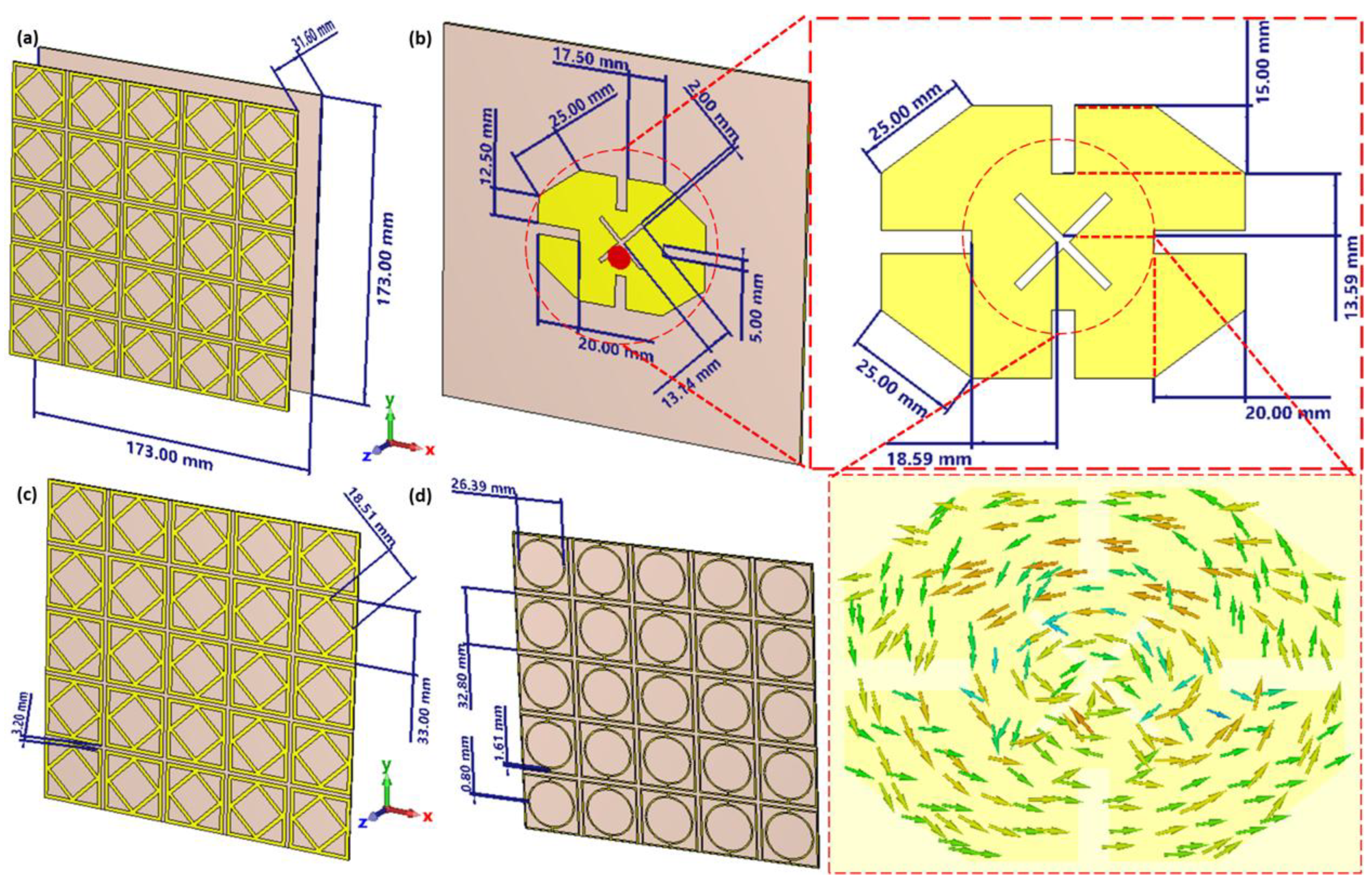
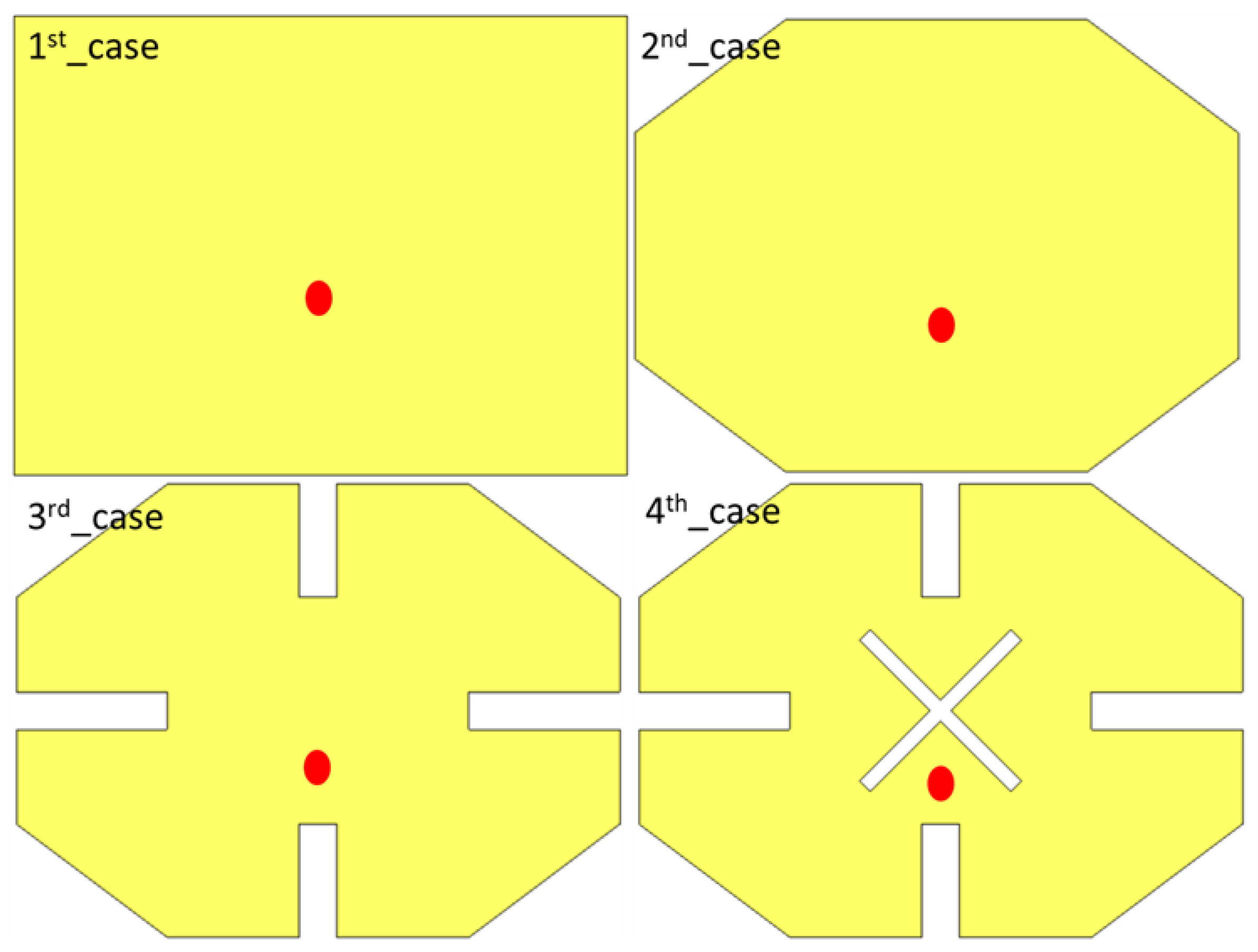
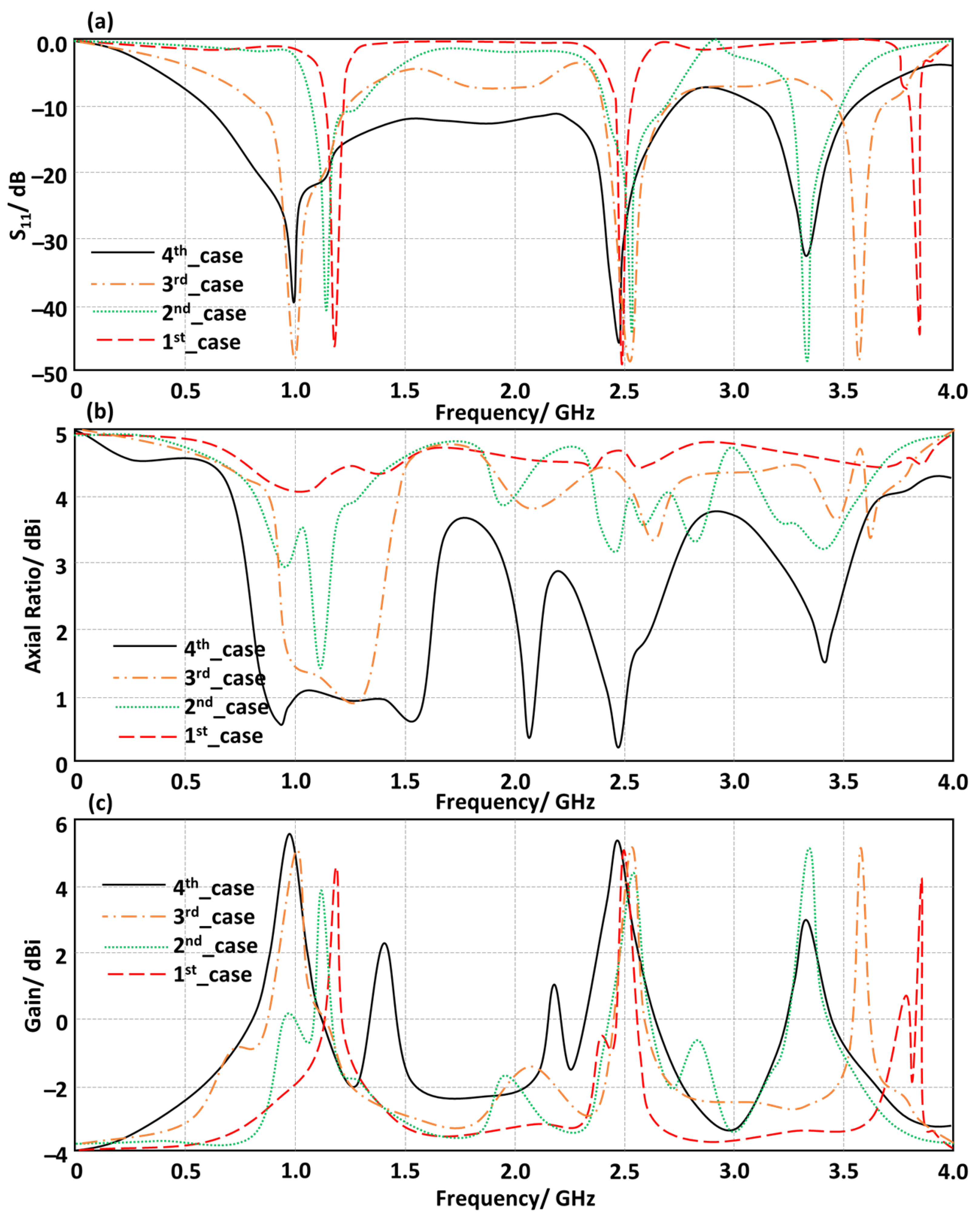
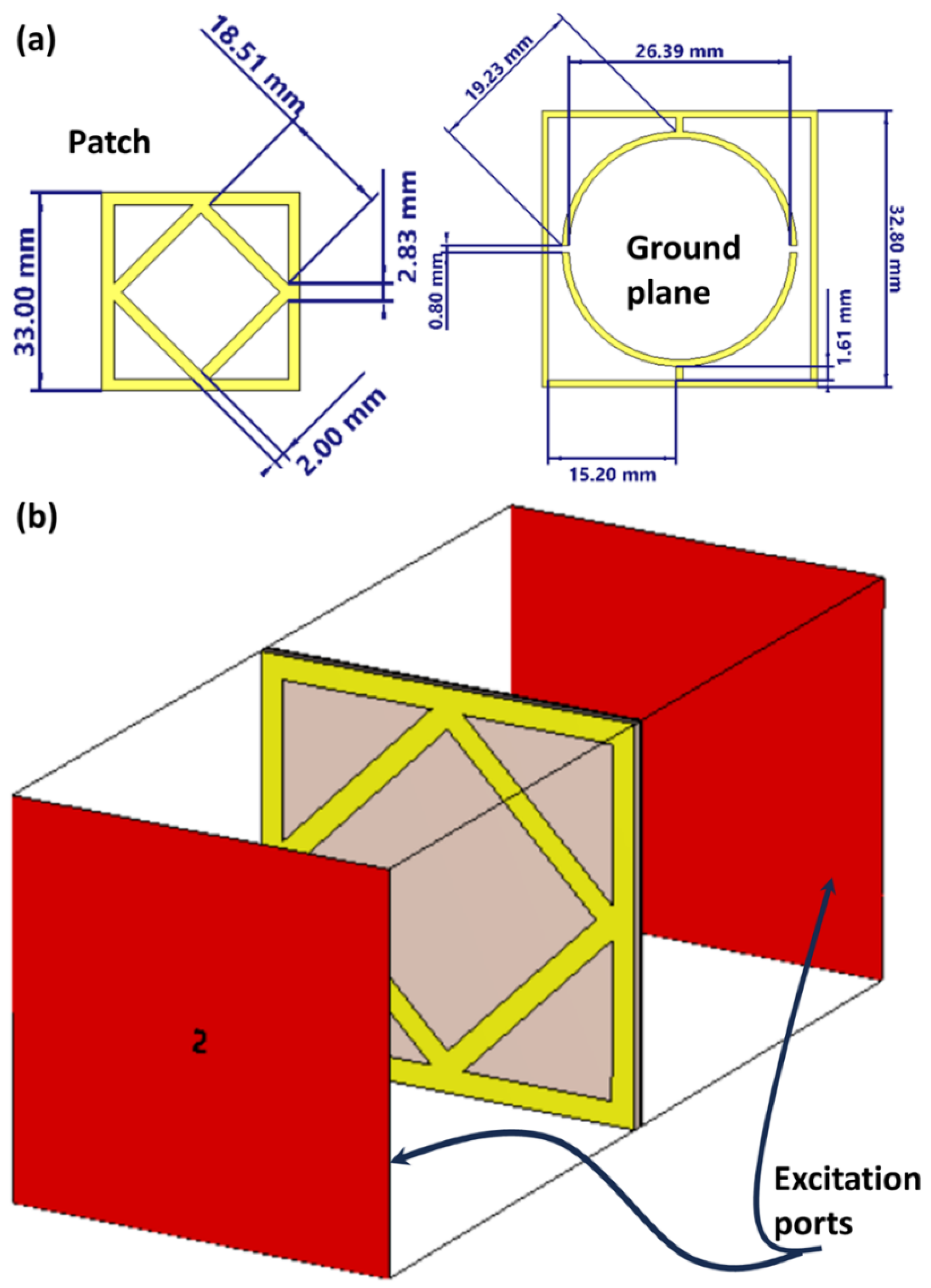
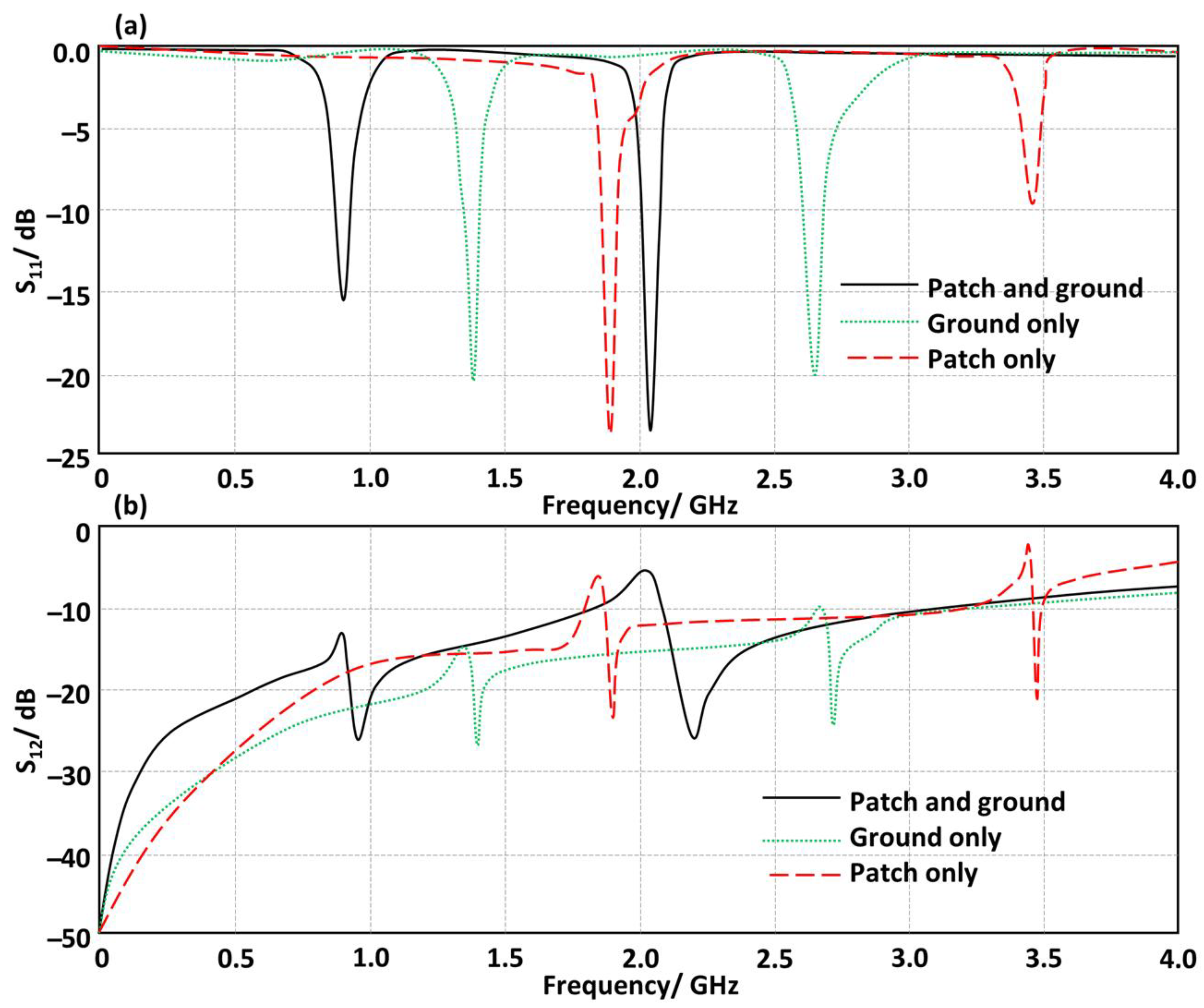
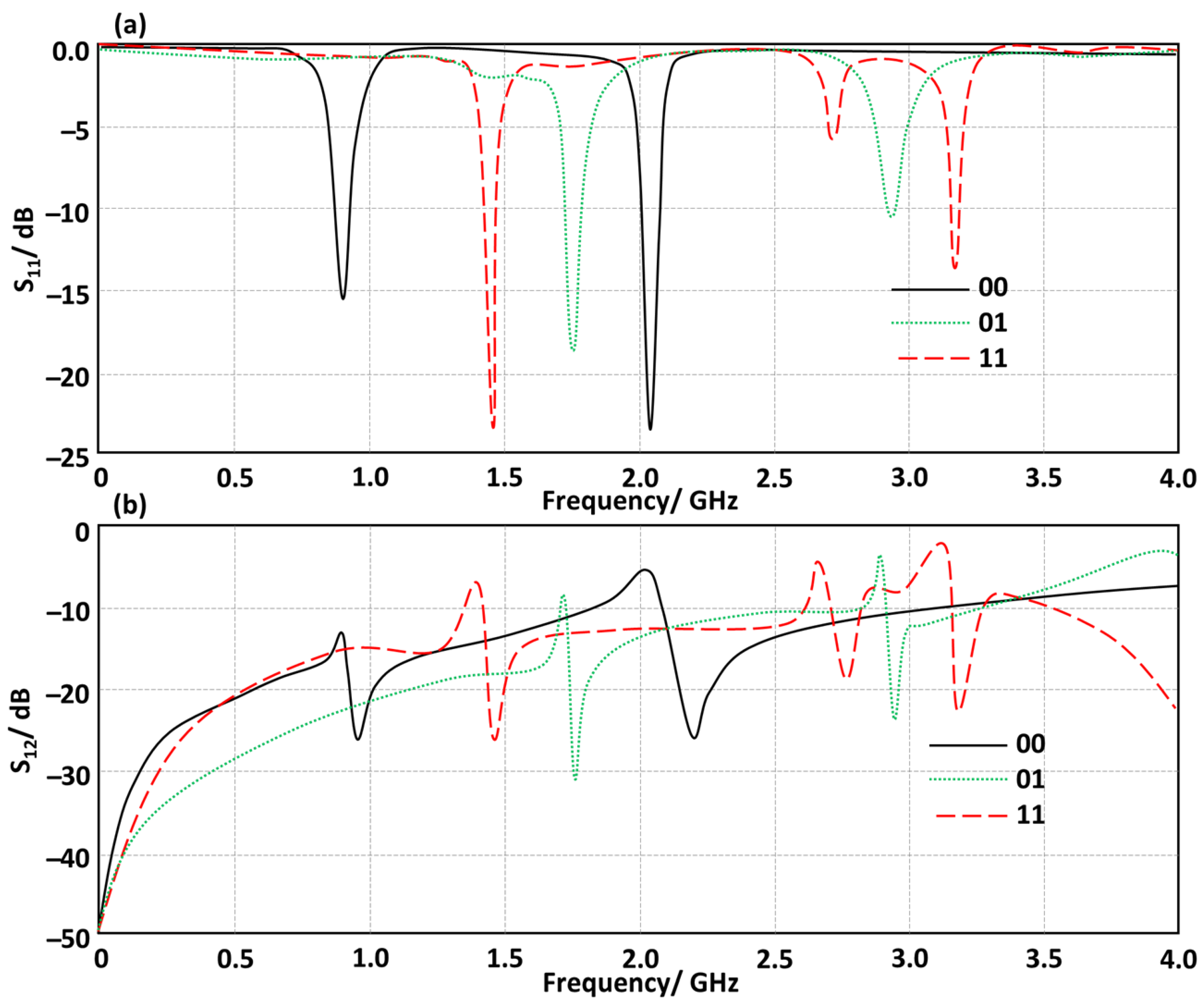
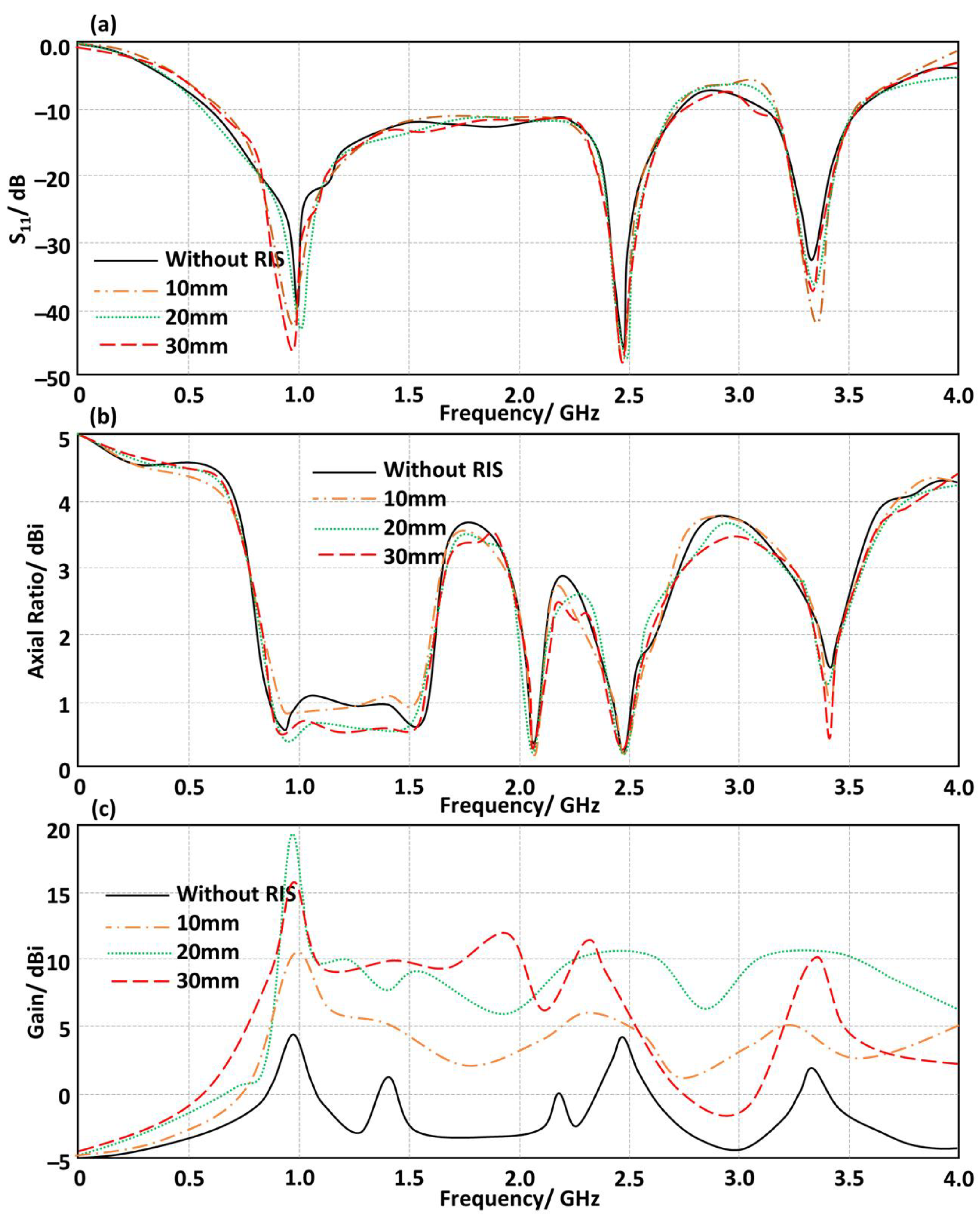
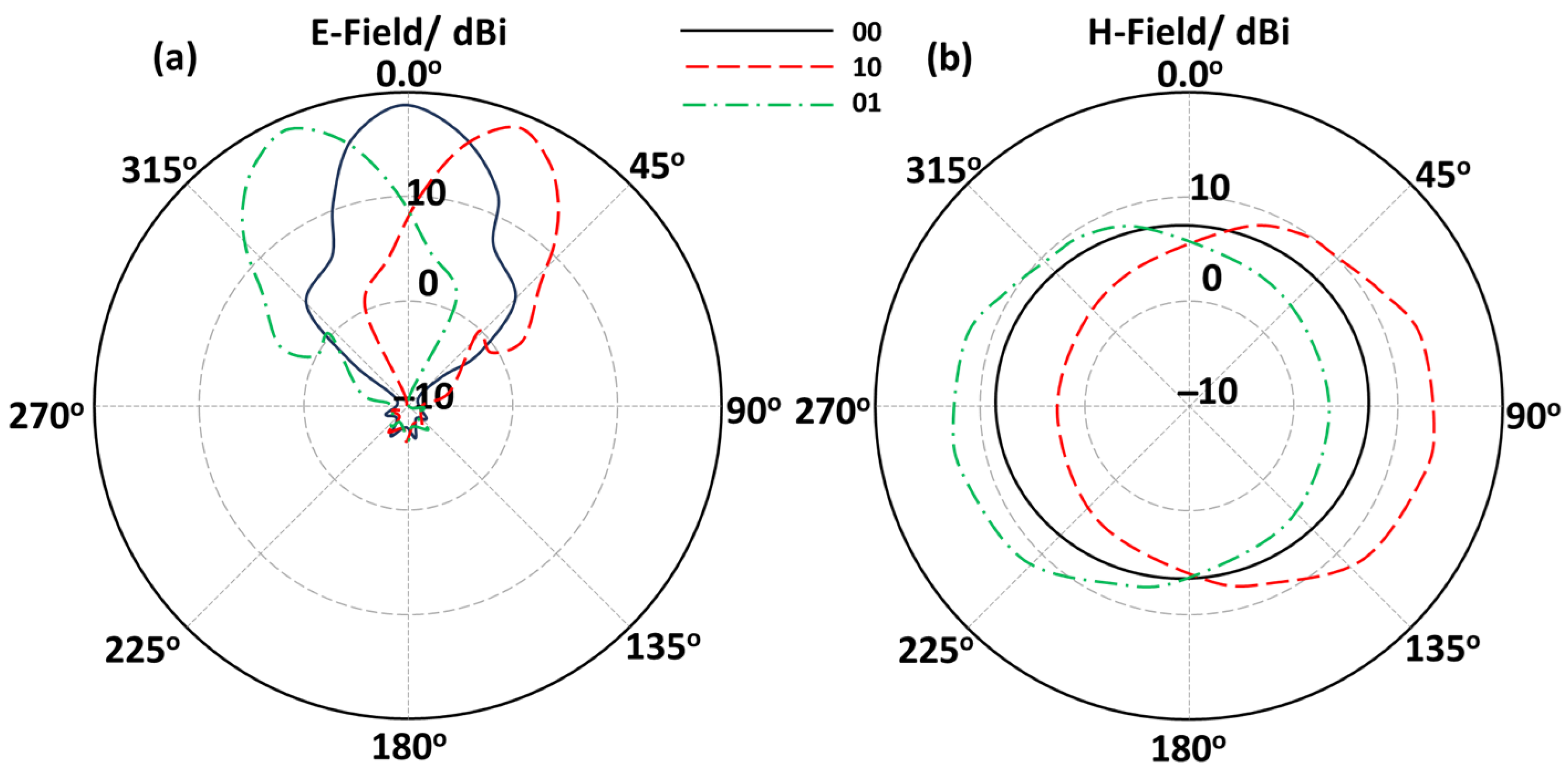
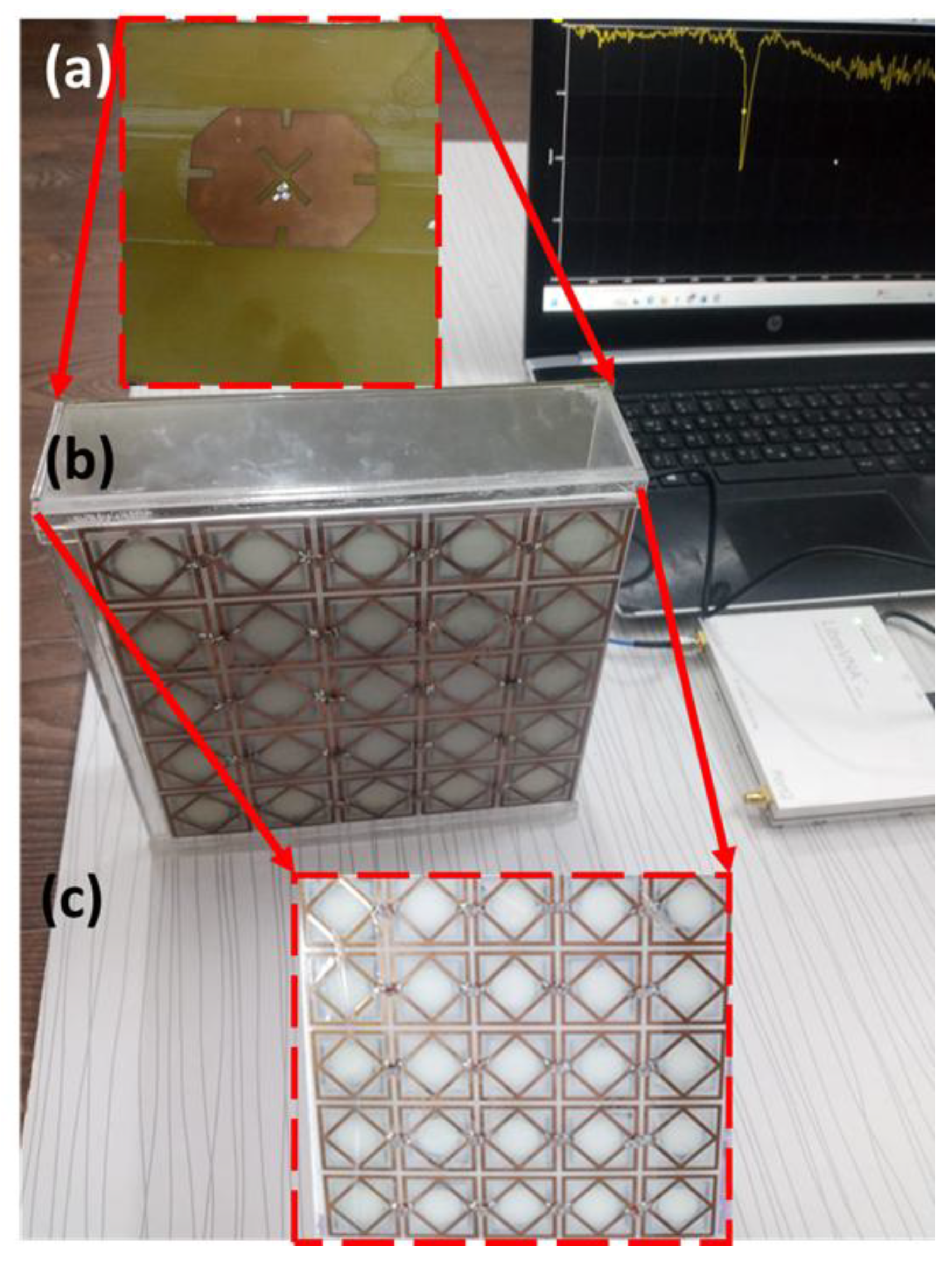
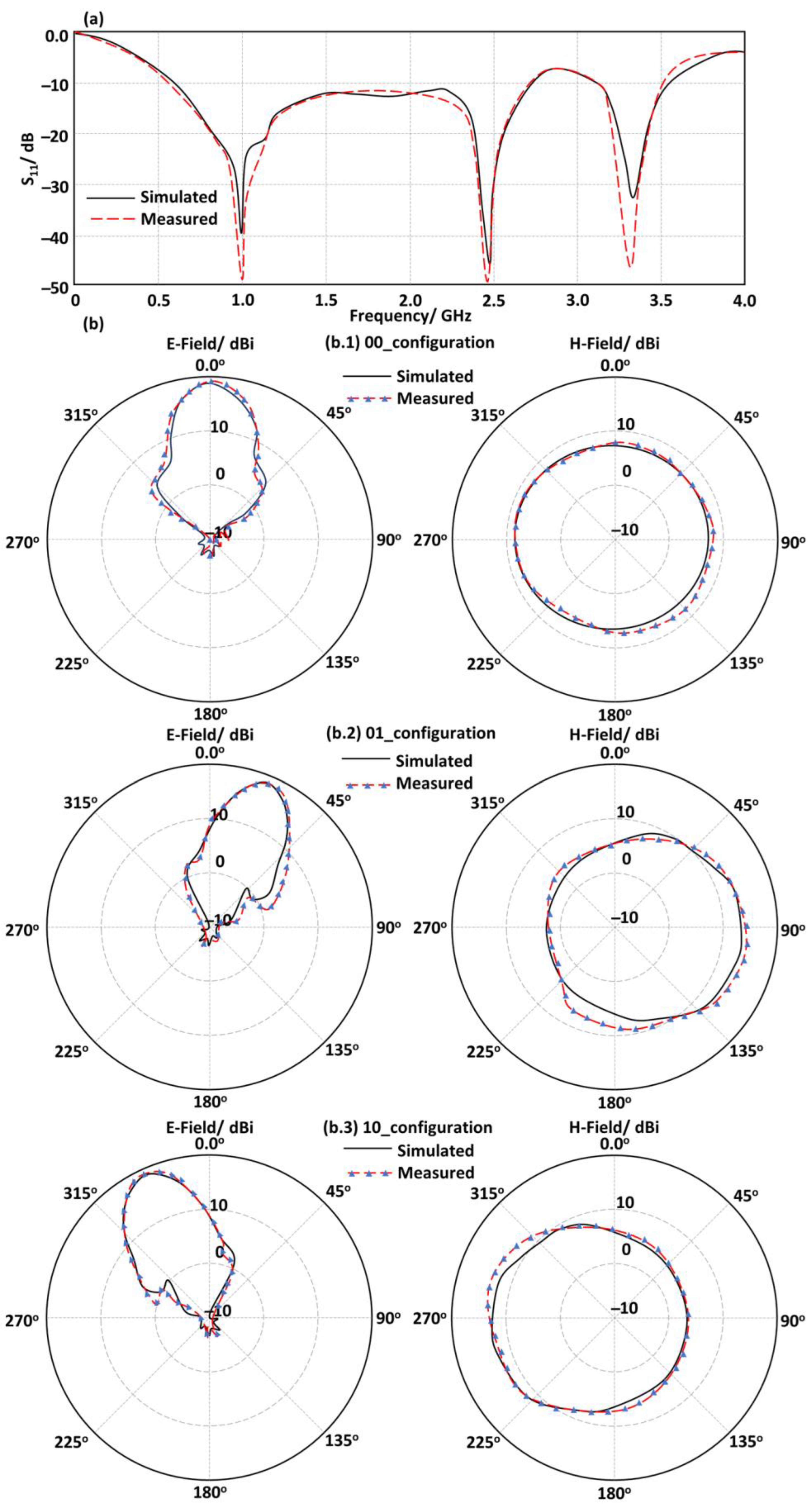
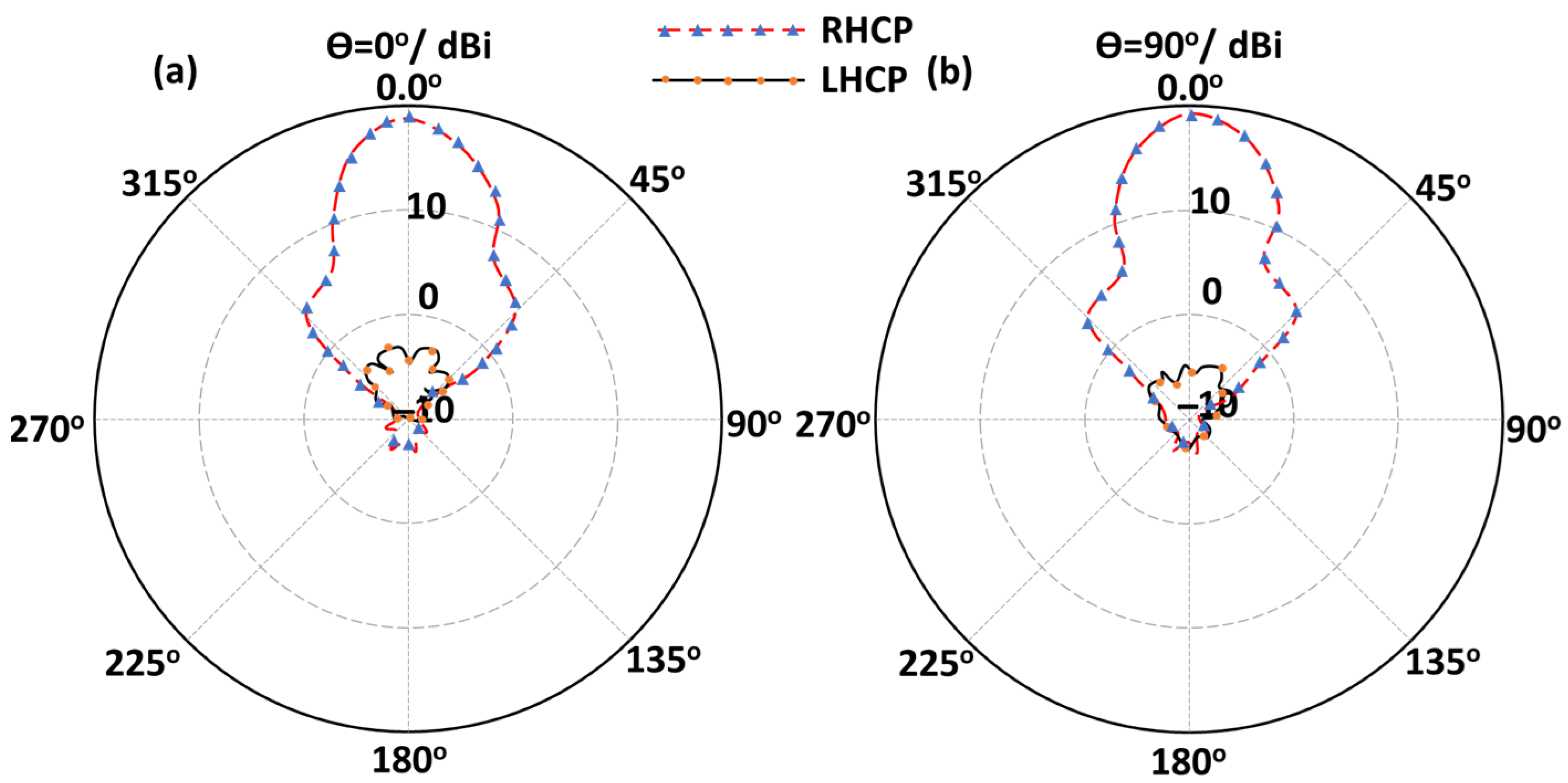
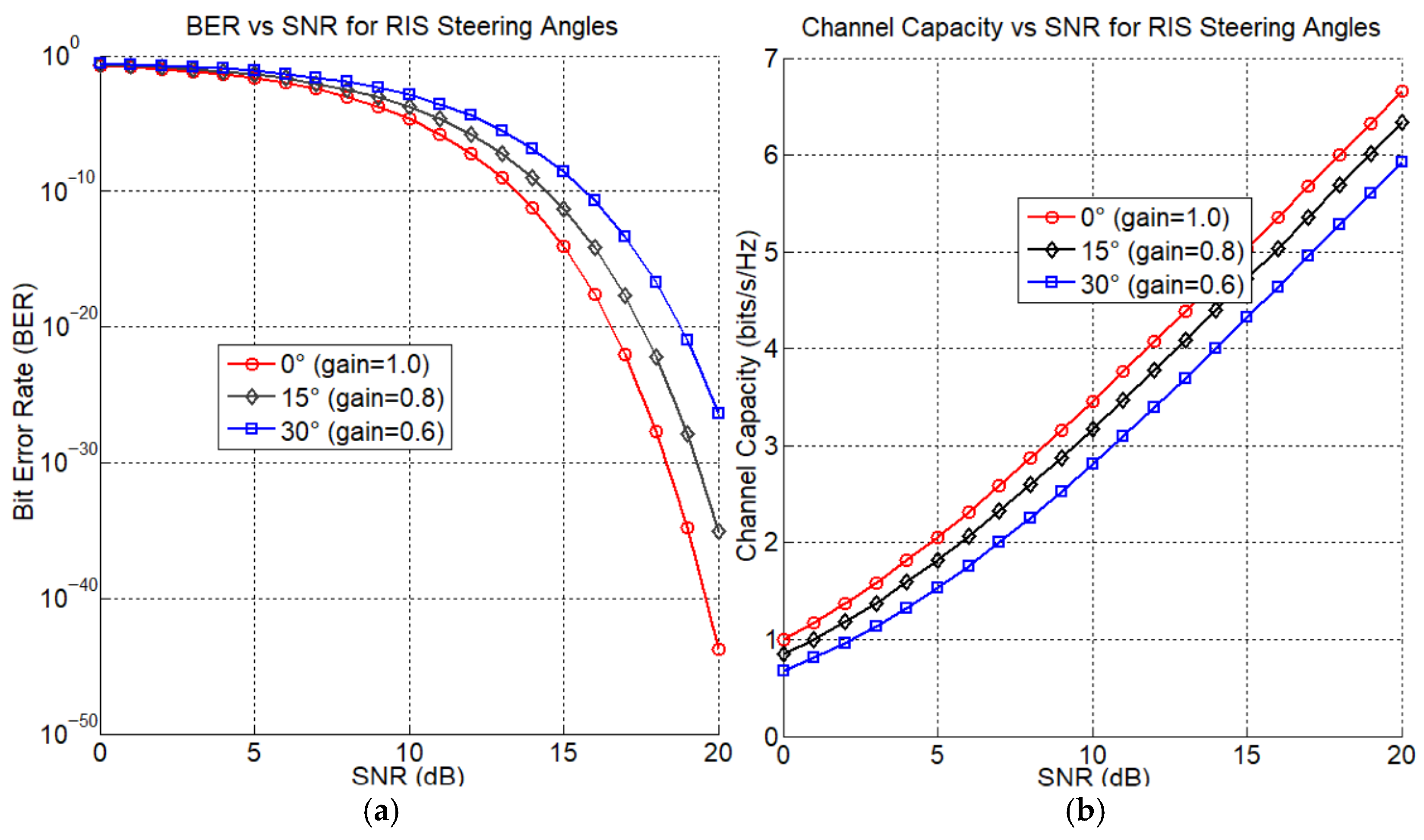
| Size/mm2 | Bandwidth (BW) | Gain | Beam Steering Angle | CC Impact | Switching Technique | Ref. |
|---|---|---|---|---|---|---|
| 173 × 173 | 0.9–3.5 GHz (~2.6 GHz span) | 10.5–16.8 dBi | ±22° | Capacity: ~5.4 bits/s/Hz at 0° steering (16.8 dBi), ~4.8 bits/s/Hz at ±22° (10.5 dBi); BER < 10−5 at SNR > 15 dB | LDR | This Work |
| 800 × 800 | 350 MHz (−1 dB BW) | 23 dBi at 2.3 GHz; 19.1 dBi at 28.5 GHz | 0–60° (broadside) steering | Not explicitly stated | 2-bit phase shifting with PIN diodes | [29] |
| 300 × 300 | 22.5–29.5 GHz (26.9% fractional BW) | (Not specified indBi) | ±50° | Not quantitated | One-bit PIN switches | [30] |
| 400 × 400 | Dual-band | (Not specified) | ±35° (sub-6), ±30° (mmWave) | Not quantitated | RF switches controlling shared aperture | [31] |
| 210 × 140 | ~4% BW at 5 GHz | ~8 dBi | ±40° elevation and multi-azimuth | +29% coverage capacity, +16% throughput | PIN diode-controlled pixels | [32] |
| 140 × 200 | Dual-frequency | (Not stated) | 10–45° at 27 GHz and 31 GHz | +50% at 20 dB SNR; +84% at 60 dB | Varactor tuning via ML biasing | [33] |
Disclaimer/Publisher’s Note: The statements, opinions and data contained in all publications are solely those of the individual author(s) and contributor(s) and not of MDPI and/or the editor(s). MDPI and/or the editor(s) disclaim responsibility for any injury to people or property resulting from any ideas, methods, instructions or products referred to in the content. |
© 2025 by the authors. Licensee MDPI, Basel, Switzerland. This article is an open access article distributed under the terms and conditions of the Creative Commons Attribution (CC BY) license (https://creativecommons.org/licenses/by/4.0/).
Share and Cite
Abed, M.A.; Uçan, O.N. Reconfigurable Intelligent Surface-Assisted Antenna Design with Enhanced Beam Steering and Performance Benchmarking. Electronics 2025, 14, 4039. https://doi.org/10.3390/electronics14204039
Abed MA, Uçan ON. Reconfigurable Intelligent Surface-Assisted Antenna Design with Enhanced Beam Steering and Performance Benchmarking. Electronics. 2025; 14(20):4039. https://doi.org/10.3390/electronics14204039
Chicago/Turabian StyleAbed, Mustafa Adnan, and Osman Nuri Uçan. 2025. "Reconfigurable Intelligent Surface-Assisted Antenna Design with Enhanced Beam Steering and Performance Benchmarking" Electronics 14, no. 20: 4039. https://doi.org/10.3390/electronics14204039
APA StyleAbed, M. A., & Uçan, O. N. (2025). Reconfigurable Intelligent Surface-Assisted Antenna Design with Enhanced Beam Steering and Performance Benchmarking. Electronics, 14(20), 4039. https://doi.org/10.3390/electronics14204039




